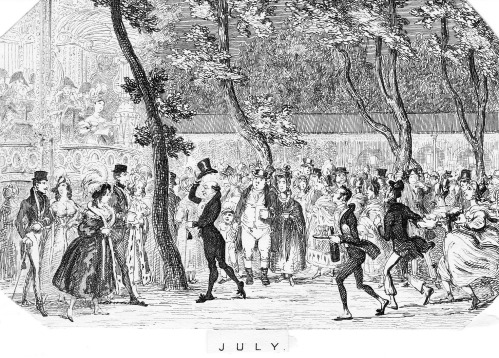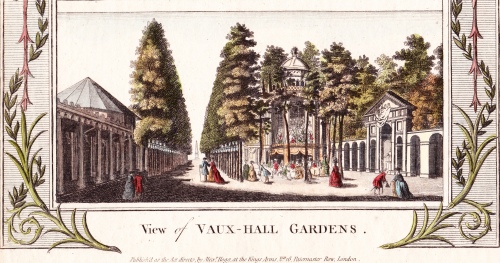Despite a packed day of sightseeing on Monday, as reported in my last post, Mr Whittock, author of The Modern Picture of London still expected his readers to be on parade bright and early the next day.
Starting at half-past nine, proceed eastward, enter Somerset House –
For centuries the site of a royal palace, the Somerset House we see today was built from 1775 onward with the east and west wings completed in 1835. It was used by government departments including the Tax Office, and the Navy Office and by institutions such as The Royal Academy (until 1836), the Royal Society, and the Society of Antiquaries. The 1809 view below of Somerset House and the New Church, Strand taken from the Morning Post Office shows St Mary le Strand. The church was built in 1714-17 on the little green that used to be the site of the Strand maypole.

– see King’s College;
King’s College was founded in 1828 with the support of the Duke of Wellington, the Archbishops and thirty bishops of the Church of England to counter the foundation in 1826 of University College – ‘the godless institution’. University College was intended to educate those not of the Church of England who had previously been excluded from a university education by the regulations at Oxford and Cambridge against Roman Catholics, Jews and Dissenters.
– turn down Arundel Street, to the Temple; see the Fountain, Ancient Hall, and the church of the Inner Temple, which is frequently open in the morning.
For the modern explorer it is simplest to walk along the Strand, passing the Griffon in the middle of the road (marking the transition into Fleet Street and the City of London) and turn right under the arch of Prince Henry’s Rooms (number 17) down into the Inner Temple, one of the Inns of Court, still bustling with legal business. The Temple Church with its circular nave and Templar tombs is well worth visiting. The print shows it in 1808 with visitors viewing the Templar graves and the photograph shows it today from a position to the left of the print.


On leaving the Temple, enter Fleet Street, onwards to Ludgate Hill, to the north entrance of St. Paul’s.

There is morning service at St. Paul’s, which occupies about three-quarters of an hour, during which time the cathedral cannot be shown; the party, in this case, if they do not wish to hear the service sung, may proceed to the Post Office, and Goldsmiths’ Hall, then return to St. Paul’s, which it is always best to view in the morning: St. Paul’s may be seen in an hour.
As he did with Westminster Abbey, Mr Whittock appears to expect his tourists to proceed briskly around major monuments.
Next visit the Bank; observe the Pay Office, the Rotunda, and some of the offices, you need not go through them all, as they are nearly alike.
 This 1811 image is of the interior courts of the Bank, designed by Sir John Soane. Now only his massive exterior wall remains and the interior has been completely rebuilt.
This 1811 image is of the interior courts of the Bank, designed by Sir John Soane. Now only his massive exterior wall remains and the interior has been completely rebuilt.
See the Auction Mart –
The Auction Mart, situated in Bartholomew Lane, right next to the Bank, was completed in 1810. According to an article in Ackermann’s Repository of 1811, from which these two images come, ‘Its object is to facilitate the sale by auction of every species of property, and to promote the circulation of intelligence relative to that subject.’ It contained auction rooms and also suites of offices for brokers and merchants, and a coffee room. I have included images of both the coffee room and the hall because this is a place one rarely sees illustrated – and for the contrast between the studious young gentlemen in the coffee room and the jovial and portly gents in the hall.

– and Royal Exchange.

The Royal Exchange is between Cornhill and Threadneedle Street, opposite the Bank, and today is merely a shopping centre. The first Exchange was built by Sir Thomas Gresham in 1557 to provide a place for merchants to meet and transact business and was the origin of the Stock Exchange. The original building was destroyed in the Great Fire of 1660 and rebuilt in architecture that The Picture of London for 1807 describes as ‘of a mixed kind, in a bad taste…’ Each of the two fronts ‘has a piazza, which gives a stately air to the building.’ The upper floor was occupied ‘by Lloyd’s celebrated subscription coffee-house for the use of the underwriters and merchants’ – the origins of Lloyd’s of London, the insurers. This building burned down in 1838 and the one you see now was opened in 1844. Although it is now a shopping and eating venue its steps are still one of the places where a new sovereign is proclaimed.
By way of rest and refreshment, take a basin of soup at Birch’s, or any of the coffee-houses about the Exchange.
Ralph Rylance in his The Epicure’s Almanac (1815) says, ‘Let us not pass Alderman Birch’s unique refectory in Cornhill, opposite the Bank of England, without a tribute to the talents, literary as well as culinary, of the worthy alderman, who having written and published on the theory of National Defence, has here illustrated his system practically, by providing a variety of superior soups and pastry wherewithal to fortify the stomachs, and stimulate the courage of all his Majesty’s liege subjects. These aliments are served up in a superior style. On the tables are placed lemons, cayenne, and other condiments, with toasted French bread for the free use of the visitants. Throughout all the turtle season, is served up in positive perfection that maximum of high diet, real turtle soup. Here is also fine genuine forest venison exposed for sale.’ Alderman Birch was Lord Mayor in 1814 and the shop provided the turtle soup for the Lord Mayor’s Banquet. The premises on Cornhill remained until 1926.
Proceed down King William Street –
In 1829-35 King William Street was driven across a tangle of minor streets to run from the junction of Cornhill, Lombard Street and Cheapside to meet Cannon Street and then turn down to the new London Bridge – this was a very new route that the visitor was being directed along.
– to London Bridge
This was the new bridge built 1823-31 by Sir John Rennie, slightly upstream of the famous Old London Bridge. (Rennie’s bridge is the one now re-erected in Arizona and the present bridge was built 1971/2)

–and thence to the Tower

The Tower of London had, by the time Mr Whittock was writing, lost its menagerie to the Zoological Society of London, but the visitor could still be conducted around ‘to any part they may wish to see’ by the Yeoman Warders. Once again, Mr Whittock evidently expects the tourist to proceed at a fast pace because, having ‘done’ the Tower they still have a lot to do.
– and the Mint (‘the workshops are inaccessible to strangers’) ; survey St. Katherine’s Dock. Then take a boat from the Tower, and you will see the Custom House, London, Southwark, and Waterloo Bridges, with the buildings on either side of the river.
Optimistically, our guide informs us that we should Return to dine in your own apartments at five o’clock; when, by seven o’clock, the party will be sufficiently rested to enjoy the play at Covent Garden Theatre.

If you would like to try this route you can cover the majority of it by combining Walks 7 and 8 in my Walking Jane Austen’s London and Walk 9 in Walks Through Regency London















 This 1811 image is of the interior courts of the Bank, designed by Sir John Soane. Now only his massive exterior wall remains and the interior has been completely rebuilt.
This 1811 image is of the interior courts of the Bank, designed by Sir John Soane. Now only his massive exterior wall remains and the interior has been completely rebuilt.

























 Many of the fish were caught in the Thames and in 1828 a Parliamentary Committee took evidence that in 1798 there were 400 fishermen, each owning a boat and employing one boy, who made a good living between Deptford and London catching roach, plaice, smelts, flounders, shad, eels, dudgeon, dace and dabs. One witness stated that in 1810 3,000 Thames salmon were landed in the season. By the time of the Commission,eighteen years later, the fishery had been destroyed by the massive pollution of the river from water closets and the waste from gas works and factories that went straight into the river.
Many of the fish were caught in the Thames and in 1828 a Parliamentary Committee took evidence that in 1798 there were 400 fishermen, each owning a boat and employing one boy, who made a good living between Deptford and London catching roach, plaice, smelts, flounders, shad, eels, dudgeon, dace and dabs. One witness stated that in 1810 3,000 Thames salmon were landed in the season. By the time of the Commission,eighteen years later, the fishery had been destroyed by the massive pollution of the river from water closets and the waste from gas works and factories that went straight into the river.

